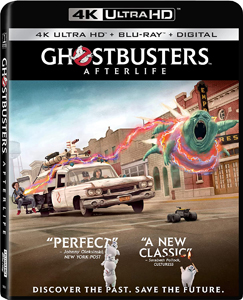“Ghostbusters: Afterlife” (2021) is the best of the three sequels. That’s a low bar to clear, but it’s also a reasonably impressive achievement. The original “Ghostbusters” is delicately positioned between humor and suspense. “Ghostbusters 2” is more bombastic and “Ghostbusters: Answer the Call” is more comedic, but neither masters that original formula.
Dusting off the old tech
This fourth film, directed and co-written by Jason Reitman (son of Ivan, director of the first two films and producer of all four), gets closer to the comedy-suspense balance thanks to sheer deliberate intent. It’s an achingly rustic nostalgia piece set on an Oklahoma “dirt farm,” tastily lensed by Eric Steelberg.
Egon (the late Harold Ramis) never bothered to grow crops, because he spent the last 30 years researching ghosts in a secret basement. When Egon’s granddaughter Phoebe (Mckenna Grace) picks through his piles of science and tech gear, the nostalgia is strong with “Afterlife.”
“Ghostbusters: Afterlife” (2021)
Director: Jason Reitman
Writers: Jason Reitman, Gil Kenan
Stars: Carrie Coon, Paul Rudd, Mckenna Grace
It can be argued we get to know Egon better than in his first two films. And a bizarrely strong case could be made that he’s the main character in this one, even though it opens with his death.
Reitman and co-writer Gil Kenan tell a story two generations after the time of Egon, Venkman (Bill Murray), Stantz (Dan Aykroyd) and Zeddemore (Ernie Hudson). But they make sure we’re thinking about the original group the whole time.
They achieve this awkward mix fairly well, in part because they don’t tell us for quite a while which O.G. (original Ghostbuster) Callie (Carrie Coon) and her two kids (Phoebe and Finn Wolfhard’s Trevor) descend from.
Personalities in place
The “getting to know them” portion of “Afterlife” is wryly amusing and lightly charming. Phoebe is an Aspie science nerd, so it’s cute when she hits it off with classmate Podcast (Logan Kim). Trevor is a lanky teen so it’s cute when diner coworker Lucky (Celeste O’Connor) likes him back.
The events unfold from the kids’ POV like an Eighties Spielberg film, which were themselves nostalgic (thus, Trevor’s drive-up diner is straight out of 1962). Callie is shockingly cynical – by today’s supportive-parent standards – about Phoebe’s interest in science. Paul Rudd’s Grooberson could be a good teacher, but he’s sidelined fairly quickly by the local ghost infestation.
But what happened to the old-school notion of character arcs? Phoebe, Podcast, Trevor and Lucky are who they are, start to finish – despite Callie’s and Phoebe’s ironic encouragement to each other that they “Don’t be yourself” on the first day of school or a date.

There’s value in encouraging kids to embrace their natural traits, but it can make for a flatter movie – unless the person who is just being their own self is Murray. But despite a carefully calibrated finale where we’re asked to remember Ramis without getting too creepy with a CGI ghost Egon, the old gang doesn’t get much screentime.
Gen Wry
The new generation remains in the shadow of its predecessors, partly because the film is designed this way, partly because these kids are safely written. One of Phoebe’s traits is that she tells groaner jokes. After Trevor’s meet-awkward with Lucky, the town kids call him “Casanova,” but it’s merely light jibing. None of those teens become characters, let alone antagonists.
Every scene with Rudd and Coon sparkles thanks to their veteran comedic timing, like when Grooberson agrees to Callie’s suggestion of dinner before she finishes the sentence. Phoebe claims to be vomiting on the inside (she doesn’t show emotions like “everyone else”), but I wonder if she actually thinks Grooberson would make a cool stepdad. Between her Aspie-ness and Gen-Z wryness, I can’t tell.
Grooberson starts his summer school session with a VHS screening of “Cujo.” This is an outright comedic flex compared to the dry humor that percolates “Afterlife.” This style seeps into Gen-Xers Callie and Grooberson, as well as the Boomer Ghostbusters.
The wryness — along with the lack of arcs for the youngsters, and the lack of a new central villain — keeps this film tethered to the 1984 original. These people aren’t doing their own thing; they’re investigating the old days.
“Ghostbusters: Afterlife” is easy to watch, inoffensively pleasant, and totally tapped in to why we like this saga. But it never earns smiles and thrills on its own. It’s a ghost of its former self, but when the former self is an all-time classic, that’s enough to get by.

